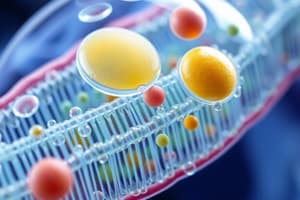Podcast
Questions and Answers
What is the structure of the human cell membrane?
What is the structure of the human cell membrane?
Phospholipid bilayer
What is membrane permeability?
What is membrane permeability?
The ease with which substances can pass through the cell membrane
Which types of membrane channels are mentioned?
Which types of membrane channels are mentioned?
- Leak channels
- Voltage-gated channels
- Ligand-gated channels
- All of the above (correct)
What are the two main types of membrane transport?
What are the two main types of membrane transport?
Simple diffusion requires energy to transport substances. True or ______?
Simple diffusion requires energy to transport substances. True or ______?
What type of substance can pass directly through the lipid bilayer?
What type of substance can pass directly through the lipid bilayer?
The cell membrane is selectively permeable.
The cell membrane is selectively permeable.
Which of the following is NOT a type of active transport?
Which of the following is NOT a type of active transport?
What causes an increased diffusion rate of a substance?
What causes an increased diffusion rate of a substance?
What influences the rate of simple diffusion?
What influences the rate of simple diffusion?
Flashcards are hidden until you start studying
Study Notes
Human Cell Membrane Structure
- Composed of a phospholipid bilayer which consists of hydrophilic heads and hydrophobic tails.
- Restricts passage of water and water-soluble ions, making the membrane selectively permeable.
Membrane Proteins Functions
- Integral Proteins: Provide structural integrity to the cell membrane and form channels for diffusion.
- Channel Proteins: Allow water-soluble substances (like glucose) and electrolytes to cross the membrane.
- Carrier Proteins: Facilitate the transport of specific substances across the membrane.
- Receptor Proteins: Serve as sites for hormone and neurotransmitter binding.
- Enzymatic Proteins: Control biochemical reactions occurring at the membrane.
Membrane Transport Definitions
- Cell-Membrane Transport: Mechanisms that regulate the passage of solutes and molecules through the membrane.
- Permeability: Degree to which substances can pass through the membrane. Characterized as impermeable, freely permeable, or selectively permeable.
Types of Membrane Channels
- Leak Channels: Continuously open pores that allow substances to pass freely.
- Voltage-Gated Channels: Open in response to changes in electric potential across the membrane.
- Ligand-Gated Channels: Open when neurotransmitters or hormones bind to receptor sites outside the cell.
Transport Mechanisms
-
Passive Transport: Does not require energy. Includes:
- Simple Diffusion: Movement from high to low concentration or according to an electrochemical gradient.
- Facilitated Diffusion: Uses protein channels to transport substances.
- Osmosis: Movement of water through a selectively permeable membrane.
-
Active Transport: Requires energy (ATP). Includes:
- Primary Active Transport: Directly uses ATP to transport substances against their gradient.
- Secondary Active Transport: Utilizes the energy from primary transport processes.
- Vesicular Transport: Involves exocytosis (exporting substances) and endocytosis (importing substances).
Simple Diffusion
- Involves the passive transport of molecules and ions based on concentration gradients without energy usage.
- Lipid-soluble and non-polar molecules, such as oxygen and carbon dioxide, diffuse easily through the lipid bilayer.
Factors Influencing Simple Diffusion Rate
- Concentration Difference: Greater differences between the two sides of the membrane result in faster diffusion.
- Molecular Size: Smaller molecules diffuse more easily across the membrane than larger ones.
- Open Channels: The presence of more open protein channels enhances the rate of diffusion for specific ions and molecules.
Conclusion
- Understanding the components and functions of the cell membrane is crucial for grasping how substances are transported, which is vital for cellular homeostasis and communication.
Studying That Suits You
Use AI to generate personalized quizzes and flashcards to suit your learning preferences.



